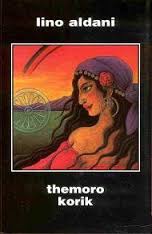Clearly, the attractive seduction of the ideal Gypsy lifestyle is easy to see: outside the grid, no taxes to pay, traveling wherever and whenever with whomever, no responsibilities other than to oneself, no consequences to engaging in what may be defined as some illegal activities. Nevertheless, there is always the other side of the coin, in this case, discrimination, hate, uncalled-for beatings, detentions and arrests, etc. In addition to the lifestyle mystique, the question of Gypsy origin looms large. And here is where things start to become full of amazement: what is their original “homeland”? Are they survivors of the Atlantis upheaval? Do they come from outer space?

This last is a hypothesis suggested by Lino Aldani in his themoro korik (Perseo Libri, 2007). Lino Aldani (1926-2009) is hailed by many as the most important of Italian science fiction writers. But by any measure, themoro korik cannot be part of a list of science fiction works simply on account of the other-worldly origin of the Gypsies, suggested but not elaborated on in this novel. Aldani’s love for the Roma and Sinti (living in Northern Italy) is obvious in this and his other novel, Quando le radici (Piacenza, Science Fiction Book Club, La Tribuna, 1977). In both novels, Gypsies (more specifically, young Gypsy women) provide a possible way out for disenchanted young gadjo men: urbanized, caged-in by work and unable and unwilling to fit in a technological world, but above all who wants to find a different lifestyle.

In Quando le radici (literally, “When the roots”), Aldani seems to be suggesting that impermanence in the form of eradication of one’s past has two paths (for the gadjo). On the one hand, technology levels villages to the ground and therefore obliterates the old way of life. On the other, the possibly unchanged Gypsy nomadic life offers a fresh start. The protagonist, Arno Varin, works in the city but visits the area of the small village he was born in, and talks to the old generation of survivors who live without water and electricity and who are in constant danger of being dispossessed because a new highway is planned on the site. Gypsy peddlers come regularly to sell their wares and Arno falls in love with a young Gypsy woman. Being young and impulsive, he kills the bulldozer driver sent to prepare the ground for construction, and therefore he has to flee to save his life. His solution? Join the Gypsy peddlers.
Themoro korik (literally “the world over there”, in Aldani’s imaginative version of Romani) presents the view that the chasm between Gypsy life and non-Gypsy life is just too great to be able to make meaningful connective bridges. Towards the end of the first part of the novel, a Gypsy father, his wife, and their daughter, enveloped in round, violet-colored light, disappear into another dimension (or another, parallel world, from which the Gypsies have been kicked out millennia ago), without the protagonist having a chance to join the daughter, with whom he is in love. The novel is more like a write-up of an unorthodox participant observation study, in which the protagonist joins an old professor, an admirer of all things Gypsy, and meeting them, studies their ways and above all, language. Almost half of the book is dedicated to a glossary of Gypsy terms, coming from both Hervatsko Roma and Sinto Lombardo, given as equivalents to the Italian lemmas. One can only wonder if all of these equivalents are in use or are genuine, as the introduction to the glossary notes that “lo zingaro e` svogliato e mentitore… ama scherzare e prendere in giro il gagio che l’interpella” (p. 153; “Gypsies are indolent and liars…they love to joke around and make fools of non-Gypsies who consult them”). Linguists have characterized Romani as an Indo-Aryan language, therefore Romani cannot support Aldani’s other-worldly origins.
In conclusion, Django, the Gypsy who disappeared, does not pilot a spaceship, nor is he a King of his people, like Yakoub of Robert Silverberg’s Star of the Gypsies (Pyr, 2005). So Aldani’s use of Gypsy characters puts them squarely in the HIC (here) and NUNC (now) of history, even though Django and his family vanish inexplicably, from a science fiction point of view, but not from the point of view of a fantasy, a very poorly elaborated fantasy nonetheless.
